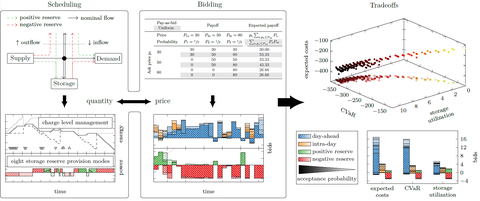01.06.2022
Neue Veröffentlichung des Lehrstuhls in Applied Energy

Bei der Teilnahme am Energiehandel über Auktionsmärkte muss gleichzeitig über verfügbare Energiemengen (Scheduling) sowie die Gebotspreise (Bidding) entschieden werden. Da beide Entscheidungen stark voneinander abhängig sind und durch die Akzeptanz bzw. die Ablehnung von Geboten beeinflusst wird, ergibt sich ein schwieriges Planungsproblem mit zahlreichen Tradeoffs.
Wir freuen uns die Publikation des Artikels "Integrated scheduling and bidding of power and reserve of energy resource aggregators with storage plants" in Applied Energy bekannt zu geben.
Abstract
Participants in energy auction markets must simultaneously decide on the quantity and price of their offers while attempting to ensure bid acceptance through the market clearing process. To participate profitably in these markets, energy resource aggregators require accurate knowledge about the costs and quantity of electricity that can be produced and consumed, i.e., knowledge about scheduling decisions.
When scheduling and bidding decisions are combined, complex interdependencies arise. Integrated scheduling and bidding with pay-as-bid remuneration has long been treated as a non-linear problem. However, by sampling stochastic parameter distributions, a practical and useful mixed-integer linear programming formulation for the integrated problem can be derived. Within the sampled distribution, the integrated model produces a priori optimal expected profit decisions. Recently, such a linear formulation for a price-taker with pay-as-bid remuneration was proposed for the first time. Our contribution completes that formulation to guarantee non-anticipativity, standardizes it with uniform remuneration, and extends it to integrated scheduling and bidding of energy and control reserve. An additional focus is placed on reserve provision through storage plants. A novel reserve scheduling model with reserve availability guarantees is introduced. This allows for leveraging the full flexibility of storage plants and, simultaneously, reveals information about the direction of reserve power flows.
The integrated model is validated in a case study based on real-world data by investigating trade-offs for scheduling and bidding decisions through analysis of the Pareto front of three competing objectives. The results show that a large proportion of bids are placed at price levels with high acceptance probability, which reduces risk. Decreasing storage utilization rates increase risk and reduce solution robustness because of lost flexibility, and result in increased reserve market participation.
Autoren
Leopold Kuttner
